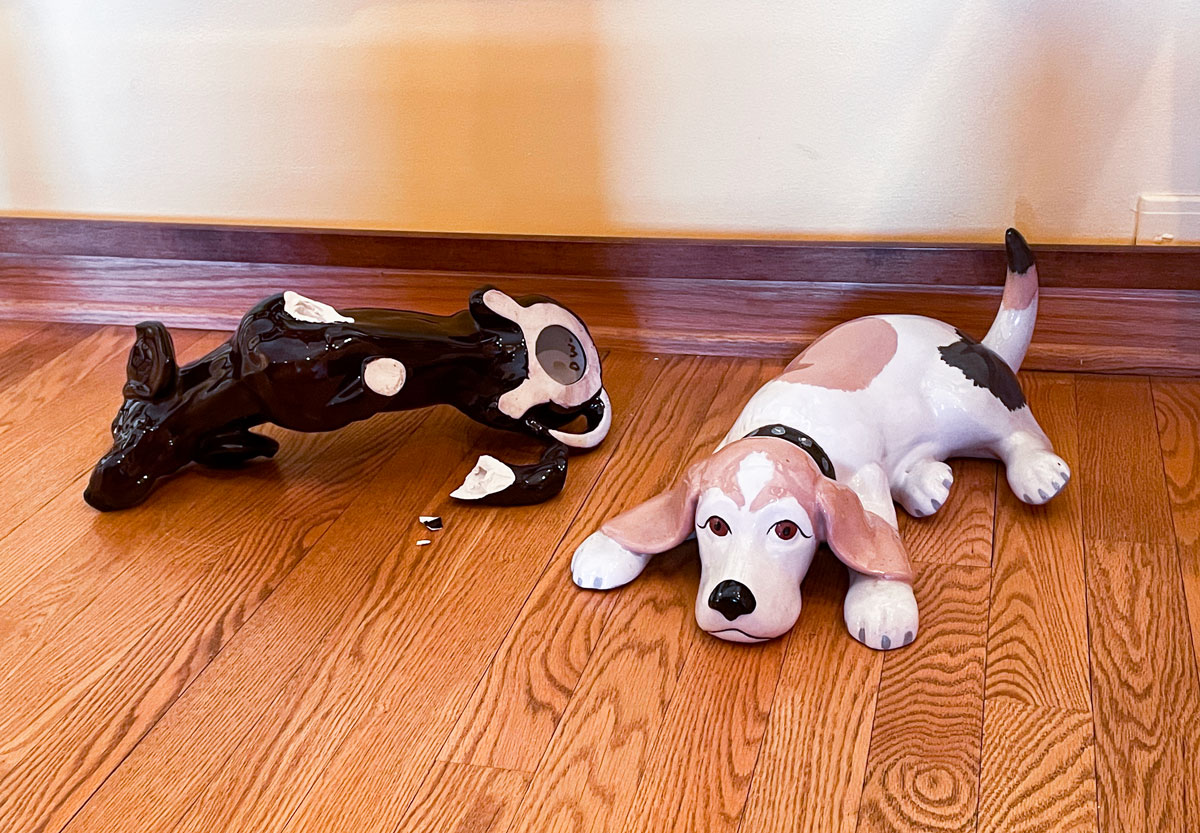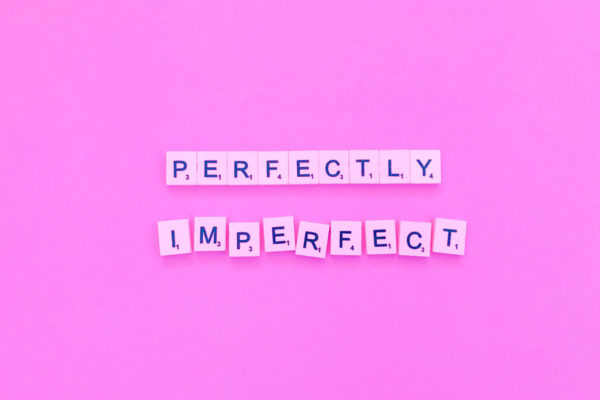Celebrating Imperfection
“The world breaks everyone and afterward many are strong at the broken places.”
– Hemingway, 1929
Recently, my grandkids had a disagreement while remote schooling at my home during the pandemic.
They excitedly chased around until they tripped, falling over each other and the shiny cocoa brown ceramic dog painted by their great grandfather, may his memory be a blessing. Their fighting immediately ceased as the kids sadly looked down, surveying the damage.
After helping the crying child to calm, we discussed what had happened. Each of us felt distressed – grammy, grandpa, and each child. Later, their mom, granddaughter of the dog artisan, was also feeling heavyhearted about the broken treasure.
Yes, a front leg of the dog great grandpa painted was broken, and yes, each of us treasured the object. Then it occurred to me to remind my daughter that although filled with meaning, the ceramic dog was a “thing”, an inanimate object. So, we talked with the kids about what had happened, what they might have done differently, and what we each could learn. Each child shared their unique reaction – we are all works in progress after all.
After deciding to repair the broken dog, I researched various methodologies. The following week the cracks were mended. Some thoughts and inspirations came my way during the process that I’d like to share with you.
1. Integrate what’s broken: heal, learn, and strengthen. The eastern philosophies of Wabi-sabi and Kintsugi offer contrast, inspiration, and perhaps liberation from long held western ideals about beauty and perfection. Each of these practices sees cracks and imperfections as objects of beauty to be celebrated, rather than hidden or disguised (Buetow & Wallis, 2019).
Think about this my friends – rather than treating vulnerability and broken-ness with contempt, what if we were to embrace vulnerability, irregularity, imperfection, and aging? How would that change our viewpoints and our relationships with ourselves, each other, material objects, and the earth on which we live?
2. Acknowledge negatives, embrace positives, and leverage strengths. As a professional executive coach and life coach with a grounding in positive psychology, I’ve learned to adopt a strengths-based approach to many of life’s challenges. Thus, in the heat of the broken ceramic dog situation, I was somehow able to insert a mindful pause (Niemiec, 2018), which is becoming a positive habit in my own life toolbox.
Here’s what I think happened. I paused just a second for a mindful breath – Ok maybe it was a big sigh! Then I called on a few of my strengths. First of all, love. The ceramic dog that we all treasured, but was accidentally broken in a heated moment, was in reality just a thing. In the big picture the children obviously mattered much more. Sharing love, kindness, and empathy with the children and helping them learn without damaging their emerging self-concepts, felt more important than the ceramic dog my dad had painted. The strength of gratitude – I am thankful for these beautiful children and the opportunity to partner with their parents and teachers, to help them learn life’s lessons. My strength of spirituality as I resonate with memories of my father, his beautiful spirit, and the oneness that connects all of us in this world and beyond.
And finally, the strength of creativity. Researching how to repair the ceramic heirloom, I explained to the children that the epoxy glue used to repair the fragments actually makes those places stronger – we can also become stronger as we learn from our broken places and difficult experiences.
Extensive scientific research shows that there are 24-character strengths common to humankind. These character strengths help people live with greater efficacy and fulfillment. Learning strategies to leverage them is part of the rigorous evidence-informed field of positive psychology, the scientific study of what makes life most worth living (Peterson & Seligman, 2004). Positive psychology recognizes that what’s good in life is as real as the negatives, not ignoring life’s adversities, but rather exploring ways to engage our strengths as we live each day.
For a framework to bring your character strengths to life, take the VIA Strengths Assessment.
To learn more about ways to understand and apply your character strengths, check out some of my blogs:
- Psychology Today blog: Flourish and Thrive: Navigating transitions with mindfulness and resilience.
- IBZ Coaching blog: “Flourish” Newsletter.
3. Things we take for granted can suddenly become very precious. In those heated moments when that favored object broke, we all had to pause to collect ourselves. It quickly became clear that the well-being of the children was more critical than the ceramic dog their grandpa painted.
In my own life, I am slowly developing my discernment muscle – learning to pause and ponder what really matters in the big picture of life as I see it. I’d like to share of few of my thoughts:
- Learn to differentiate between needs and wants.
- Accept what life serves up and be open to possibilities, even when the circumstances seem overwhelming.
- Spend time with children and older people.
- Usually when we say yes to something, consciously or unconsciously, we are saying no to something else.
- Take time each day for deep work. Notice the still small voice that calls.
- Once basic needs for food, shelter, and health are met, relationships, love, and creating a positive footprint matter more than anything.
- There are all kinds of beauty in life – look beyond the exterior and beyond the imperfections toward the light – whether it’s obscured or shining brightly.
- Be a student of life, someone who continues to grow and approaches life’s moments with a beginner’s mind.
- Strive for a sense of purpose and know your strengths, values, and philosophies.
- At our essence, as Carl Sagan said “we are star stuff” – we are sparks of light, life-force energies, innately interconnected with each other and with the world
- around us.
- Contribute to moving humanity forward, imbuing each day with love and blessing. If not now, when?
4. “There’s a crack in everything, that’s how the light gets in.” Songwriter Leonard Cohen is known for his iconic song Anthem (Cohen, The Future, 1992) and this well-known lyric. The song reminds listeners to accept imperfection while also noticing the light that lies beyond. If you’d like to listen to Anthem, here’s a link to a version on YouTube.
Send your comments and suggestions to Ilene!
Click here to send Ilene an email with your thoughts about this blog post.
References:
- Buetow, S. & Wallis K. (2019). The beauty in perfect imperfection. Journal of Medical Humanities ,40(3), 389-394.
- Cohen, L. (1992). Anthem Lyrics. (n.d.). Lyrics.com. Retrieved March 23, 2021, from https://www.lyrics.com/lyric/21933080/Leonard+Cohen.
- Hemingway, E. (1929). A farewell to arms. New York, NY: Scribner.
- Niemiec, R. (2018). Character strengths interventions: A field guide for practitioners. Boston, MA: Hogrefe.
- Peterson, C. & Seligman, E.P. (2004). Character strengths and virtues: A handbook and classification. Washington DC: American Psychological Association.
Copyright © 2021 Ilene Berns-Zare, LLC, All Rights Reserved
Ilene is a Featured Author on PsychologyToday!
Read her blog series Flourish and Thrive: Navigating transitions with mindfulness and resilience.

Do you have a symbolic “broken dog” in your life?
Tap into your strengths, purpose, and potential to flourish in life and work.
If you’d like to discuss how Ilene Berns-Zare Coaching can help you achieve your goals, Contact Ilene.
Coaching with Ilene Can Help You Call Yourself to Action
Ilene Berns-Zare, PsyD, PCC, CMC (ICF Credentialed) is an Executive and Personal Coach and Speaker. Ilene helps people live their best personal and professional lives by bringing mind, body, and spirit into flow with strengths, purpose, and potential. She inspires clients to find fresh perspectives and access their full potential as creative, resourceful, whole persons. Find Ilene online, set up a free discovery coaching consultation, and access free resources at https://ibzcoaching.com/.
Please share this blog with anyone who might be interested in reading it!
We would love to hear from you! We are interested in your suggestions for this newsletter, your reactions to this one, or providing more information about coaching.




